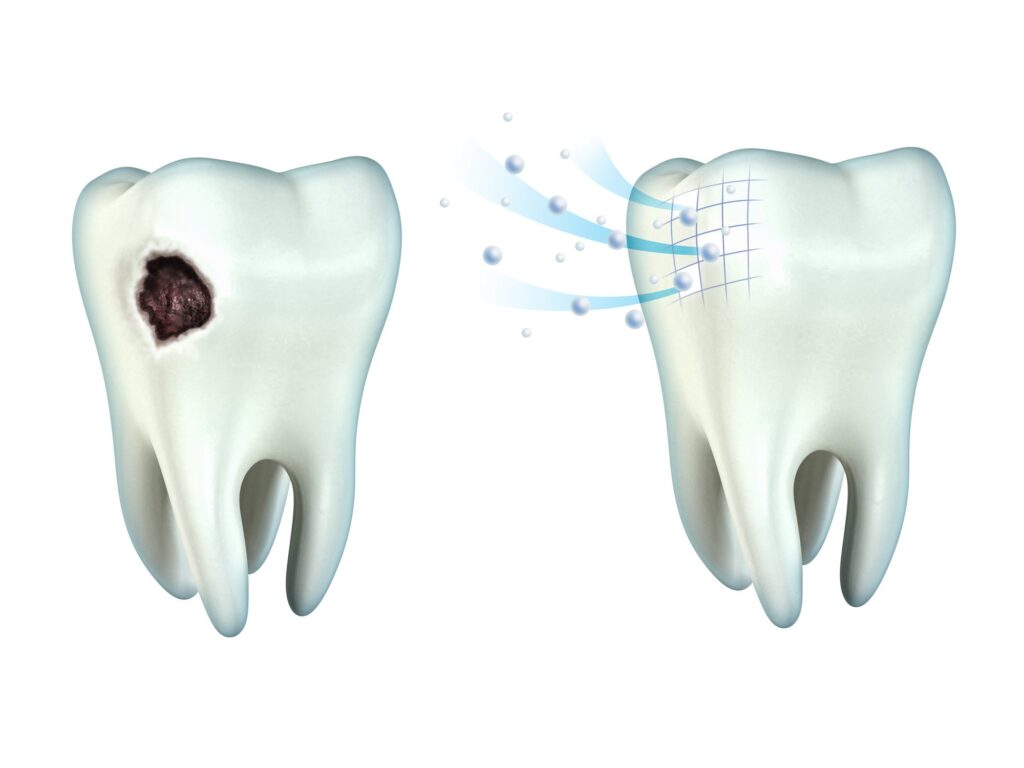
Cavities, also known as dental caries or tooth decay, are a common oral health issue that can affect anyone, regardless of age or dental hygiene practices. While cavities are commonly associated with the surfaces of teeth, they can also develop in more hidden places, such as between teeth.
Most people don’t know that this is a possibility. So they don’t get it checked until it’s too late.
A cavity in between teeth poses unique challenges and considerations due to its location. In this article, we will delve into the mechanisms behind the development of cavities between teeth and explore preventive measures to maintain optimal oral health.
Understanding Dental Anatomy
Before discussing how cavities form between teeth, it’s important to understand the anatomy of teeth. Each tooth is composed of an outer layer of enamel, which is the hardest substance in the body. The tooth also has an inner layer of dentin.
Between the teeth, there’s a small space known as the interproximal space or the contact point. This area is prone to collecting food particles and plaque due to its tight space. This makes it susceptible to cavity formation.
Some of the reasons for cavities between teeth are as follows:
Inadequate Oral Hygiene
One of the primary factors contributing to cavities between teeth is inadequate oral hygiene. When food particles and plaque accumulate between teeth, they create an environment conducive to bacterial growth.
The bacteria in plaque feed on sugars and produce acids that erode the enamel, leading to cavities. Regular brushing and flossing are crucial for removing debris and plaque from these tight spaces.
Formation of Dental Plaque
Dental plaque is a sticky, colorless film of bacteria that adheres to teeth and gum tissue. When plaque is not effectively removed through proper oral hygiene practices, it can build up between teeth.
Plaque is particularly adept at hiding in the crevices between teeth. This increases the risk of cavities forming in these areas.
Dietary Habits
The foods and beverages we consume play a significant role in cavity development. Diets high in sugars and carbohydrates provide fuel for bacteria, leading to increased acid production.
Sugary substances can become trapped between teeth, creating an ideal breeding ground for cavity-causing bacteria. Regularly consuming sugary snacks and drinks without thorough oral hygiene can heighten the risk of cavities between teeth.
Lack of Fluoride Exposure
Fluoride is a mineral that strengthens enamel and helps prevent tooth decay. Fluoride exposure can come from sources such as:
- Fluoridated toothpaste
- Drinking water
- Professional treatments
In areas with limited fluoride exposure, enamel may be more susceptible to demineralization and cavity formation, including between teeth.
Tooth Misalignment
Malocclusion or misaligned teeth can create uneven spaces between teeth. Even though some cultures (Nigerians in particular) consider this a sign of beauty and strength, it can be a deterrent to proper brushing. The space makes it challenging to effectively clean these areas through regular brushing and flossing.
Misaligned teeth can trap food particles and plaque in hard-to-reach spots, increasing the risk of cavities. Orthodontic treatments to correct tooth alignment can help minimize this risk.
Dry Mouth (Xerostomia)
Saliva plays a crucial role in oral health by neutralizing acids, washing away food particles, and providing minerals that strengthen enamel. Dry mouth, a condition known as xerostomia, reduces saliva’s protective effects.
This makes teeth more vulnerable to decay, especially between teeth where saliva may have limited access.
Even though some dry mouth symptoms are due to dehydration and not drinking enough water, others can be due to the side effects of prescription medication.
Preventing Cavities Between Teeth
After all this, you must be curious to know how you can prevent cavities between teeth. There are many ways to do so. But it does require you to stay consistent with these habits.
Regular Oral Hygiene
Brush your teeth at least twice a day. Floss daily to remove food particles and plaque from between teeth. If you don’t like traditional flossing methods, consider getting a Waterpik to floss your teeth in a jiffy.
Proper Technique
Use proper flossing techniques to ensure thorough cleaning between teeth. Gently glide the floss along the sides of each tooth, forming a C shape.
Balanced Diet
Limit sugary snacks and beverages. Opt for a balanced diet rich in fruits, vegetables, whole grains, and lean proteins.
Make sure to rinse your mouth out with water after drinking or eating something particularly filled with sugars. This way it doesn’t stick to your teeth and results in cavities down the road.
Fluoride Use
Use fluoride toothpaste. Consider fluoride mouth rinses if recommended by your dentist.
Regular Dental Visits
Schedule regular dental check-ups and cleanings to catch and address cavities in their early stages.
Even if you think you have healthy teeth, make sure to go visit a dentist for a whitening treatment at least once a year. They have an expert eye and can tell if you have a cavity in its mere beginnings. It’s better to take preventative measures right at the start than to wait until too late.
Also, if you have children, then start taking them to the dentist at an early age as well, around 4-5 years old. In fact, the earliest children can go to the dentist is 12 months old. This way they can build healthy oral health habits from the get-go.
Orthodontic Treatment
If misaligned teeth contribute to cavity development, consult an orthodontist for potential treatment options. Don’t wait until it’s too late to begin this. If finances are an issue, speak to your dentist about installments or payment plans.
Cavity in Between Teeth: Tooth Decay Can Happen Anywhere
Cavity locations are wide and varied. You might be surprised to learn that you can get a cavity in between teeth, but it’s absolutely a possibility.
Take care of your teeth by following certain oral habits and visiting your dentist regularly.
We are Katy’s #1 Dentist. If you are in the Katy, TX area and still searching for a gentle dentist, contact us to book an appointment. We can’t wait to help you create a beautiful healthy smile.

